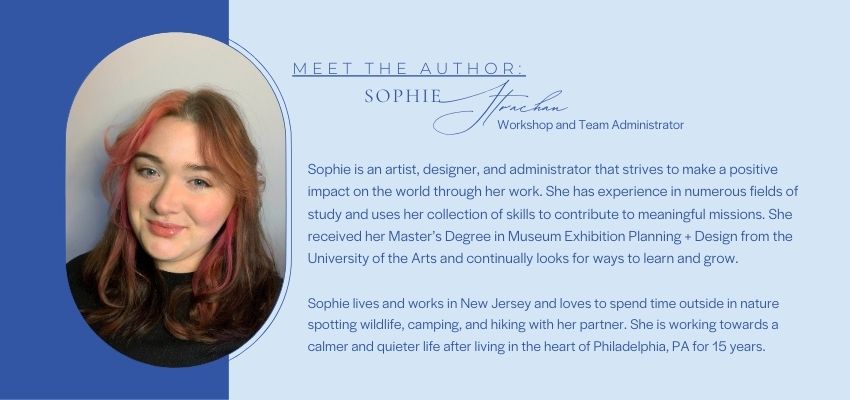The Seven Realms of Self-Care Series: Let’s Get Creative
Sophie Strachan, May 7, 2024
Find time for creativity in your work, life, and self-care! Practicing creativity can help you relieve stress, inspire motivation, heal, and stir up feelings of joy. However, creativity can, at times, feel unattainable. I can hear you saying, "But I can't even draw a stick figure..." Being creative isn't just about drawing or painting. Let's talk about how you can get creative in your everyday self-care.
Why We Need to Get Creative
According to Mihaly Csikszentmihalyi, "The best moments usually occur if a person's body or mind is stretched to its limits in a voluntary effort to accomplish something difficult and worthwhile." He calls this the "State of Flow." We achieve a state of Flow when we are so incredibly engaged in a task that we lose our concept of time, when we don't realize that hours have passed instead of minutes, and nothing other than that activity seems to matter. That level of engagement requires deep concentration and a feeling of control over the task, and it feels relatively easy. Csikszentmihalyi suggests you can increase your happiness by introducing moments of Flow through music, exercise, or art-making.
Finding moments of Flow doesn't have to be confined to a creative practice; it might be the easiest way to manifest it. You know when you're reading a book that you can't put down, and suddenly you've finished it? That's Flow. Or when you are so focused on updating spreadsheets or typing notes at work that you don't realize it's past 5 p.m.? That's Flow! Read more about the concept of Flow here.

By focusing on the task at hand and finding your Flow, you can temporarily forget about the stresses of everyday life. This can help you find a refreshed mindset that can provide a new perspective on the causes of your stress. When you have some time away from stress and overwhelm, those feelings may not feel as big.
Creativity can also help you express your emotions differently, which can be incredibly cathartic. Feelings are extremely abstract, at times complex to share and it may be difficult to describe them using words. Artists throughout history have sought to express emotions visually.
Practicing creativity can stimulate your brain in new and different ways, improving your problem-solving skills. We can become so comfortable in our routines that we repeat the same actions repeatedly, but that is only sometimes helpful when you have a new problem to solve. Thinking creatively can open up new options for finding solutions to complex issues.
Let's Get Creative
While drawing, painting, and sculpting are typical examples of being creative, they aren't the only way to work a creative practice into your life. However, if you don't want to spend a lot on supplies or you're new to art, but you're interested in drawing and painting, here are a few low-effort, low-barrier options to try:
- Zen tangle
- Coloring pages - We have been sharing a lot of coloring pages here!
- Try different abstract painting techniques
- Make a collage (it can be digital, too)
Pick up a DIY craft or hobby. While this may involve purchasing some supplies, but permit yourself to peruse your local craft store and see what interests you! There are endless hobbies and crafts available for all skill levels. Needle felting, embroidery, cross stitching, knitting, crocheting, jewelry making, tie dying, and miniatures are just a few of the many crafts you might explore. Despite Legos being an expensive hobby, they are so satisfying to complete!
Singing, playing instruments, listening to music, and dancing are great creative options! Music has an inherent power to enhance our mood; moving your body or using your voice can release all those feel-good chemicals in your brain!
If creative writing is more on your level. Try keeping a journal. Write a short story or a poem. You may find that expressing yourself through words feels more natural than you thought. Here are a few creative writing prompt lists to get started:

What if I don't want to make anything new?
Redesign your living or working space. Spending time in a comfortable, clean, and aesthetically pleasing space can make you feel good. This could be as simple as rearranging your furniture. You may have extra cash in your budget to buy art for your walls or new throw pillows. Take some time to finally organize that pile in the corner!
Visit an art museum, art gallery, or another beautiful space. Being creative doesn't always have to be you creating something. Sometimes, we can just appreciate the beautiful things that already exist. Nature is art's greatest inspiration. Take a trip to a nearby park or public garden and be present in that experience.
Cooking is an often overlooked creative practice. You can find inspiration for a new recipe and buy ingredients you might not normally consider. Try making that Beef Wellington or recreate your favorite takeout dish! The accomplishment of cooking and eating a new dish may bring you a newfound joy.
Tend to your own beautiful outdoor space! Gardening can be relaxing and rewarding if you have the time and space. Even if you only have room for a window planter or need to start your garden indoors, spending time around plants can significantly enhance your mood.
Where do you go from here?
Recognize where you can add a little creativity into your daily life. Take even just 10 minutes a day to try something creative. Practicing creativity can relieve stress, help you find moments of Flow, improve your practical problem-solving skills, and make you happy! Finally, Creativity should feel simple and manageable, so find an activity or practice that works best for you. You could even invite a friend!
Have trouble fitting new self-care activities into your schedule? Read our blog about Creating a Self-Care Routine.








